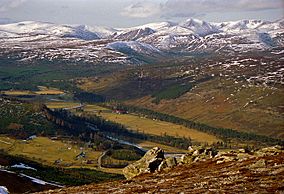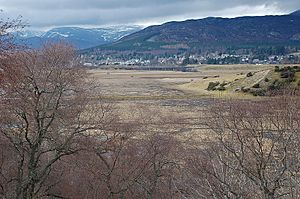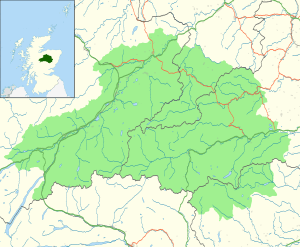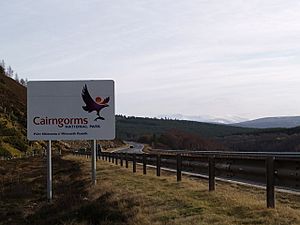Cairngorms National Park facts for kids
Quick facts for kids Cairngorms National Park |
|
|---|---|
|
IUCN Category V (Protected Landscape/Seascape)
|
|

View of the Cairngorms from Morrone.
|
|

Location and extent of the Cairngorms National Park
|
|
| Location | United Kingdom (Scotland) |
| Area | 4,528 km2 (1,748 sq mi) |
| Established | 2003 |
| Governing body | National park authority |
| Website | Cairngorms National Park |
| Official name: Cairngorm Lochs | |
| Designated: | 24 July 1981 |
| Reference #: | 216 |
The Cairngorms National Park (in Scottish Gaelic: Pàirc Nàiseanta a' Mhonaidh Ruaidh) is a huge natural area in northeast Scotland. It was created in 2003 and was the second national park in Scotland. This park is home to the famous Cairngorms mountains and the hills around them. It's the largest national park in the United Kingdom, and it got even bigger in 2010!
About 18,000 people live inside this amazing park, which covers 4,528 square kilometres. Some of the biggest towns are Aviemore, Ballater, and Grantown-on-Spey. Many parts of the park are also special nature reserves, like Abernethy Forest.
The Cairngorms National Park is a very popular place to visit. In 2018, nearly 2 million people came here. Most visitors are from the UK, but many also come from other countries. Tourism is a big part of the park's economy, making up about 80% of its income.
Contents
Exploring the Park's Geography
The Cairngorms National Park stretches across five different areas of Scotland. The famous Cairngorms mountains are at its heart. But the park also includes other hill ranges, like the Angus Glens, and lower areas like Strathspey.
Three major rivers start their journey in the park: the Spey, the Dee, and the Don. The Spey is Scotland's second-longest river. The Dee and Don both begin in the Cairngorms mountains.
The Cairngorms mountains are truly spectacular. They look a bit like the Hardangervidda National Park in Norway. They have large, flat areas called plateaux, about 1000–1200 metres high. On top of these plateaux are rounded mountain peaks, reaching around 1300 metres. Many peaks have "tors," which are cool, free-standing rock formations. The edges of these plateaux have steep granite cliffs, perfect for skiing, rock climbing, and ice climbing.
The Cairngorms have an "arctic-alpine" environment. This means it's like a tundra with very cold weather and snow that stays for a long time.
The Monadhliath mountains are north of Strathspey. They are a wide, open plateau, between 700 and 950 metres high.
Two main routes go through the park. The A9 road and the Highland Main Line railway cross the Pass of Drumochter. They connect the park to cities like Perth and Inverness. Other important roads also run through the park, linking different areas.
How the Cairngorms Were Formed (Geology)
The rocks in the Cairngorms National Park are very old. Most of them are from the Dalradian Supergroup. These rocks were once sand, mud, and limestone deposited about 800 to 600 million years ago.
Later, huge forces deep inside the Earth folded and changed these rocks. This happened during a time called the Caledonian Orogeny, about 490 to 430 million years ago. Giant blobs of hot, melted rock, called granite, pushed up into the older rocks and cooled down. The largest of these granite blobs formed the Cairngorms mountains we see today. This happened about 427 million years ago!
Over millions of years, the land was worn down. The granite that was once deep underground is now at the surface. The ice ages, which happened over the last 2.5 million years, also shaped the landscape. They left behind features like peat bogs and landslips.
Amazing Nature and Wildlife

The Cairngorm mountains offer a special "alpine" habitat. It's like a semi-tundra moorland where many rare plants and animals live. You might spot birds like ptarmigan, dotterel, snow bunting, and golden eagle. Mammals include red deer and mountain hare.
The park is also home to the only herd of semi-domesticated reindeer in the British Isles. They were brought here in 1952 from Sweden. Now, there are about 150 reindeer roaming the high Cairngorms.
The valleys and glens in the park have ancient forests called the Caledonian forest. The huge pine forest from Glen Feshie to Abernethy is the biggest of its kind left in Scotland. More than half of all remaining Caledonian forest is in this park! In these forests, you can find birds like capercaillie, black grouse, and crested tit.
The entire River Dee is a special area for nature. It's important for salmon, otters, and freshwater pearl mussels. The River Don also has many fish.
In upper Strathspey, the Insh Marshes are one of Scotland's largest wetland areas. Many birds come here to breed in summer, including osprey, ducks like wigeon, and wading birds like curlew. In winter, greylag geese from Iceland and up to 200 whooper swans visit the marshes.
The Cairngorms National Park is a "Category V" protected area. This means people have lived and worked here for a long time. The park is managed to protect the special landscapes and habitats that have formed from this interaction.
Many areas within the park have extra protection. There are 19 Special Areas of Conservation and 46 Sites of Special Scientific Interest. Nine of Scotland's national nature reserves are also found here, including Abernethy Forest and Mar Lodge Estate.
History of the National Park
People have wanted to protect parts of Scotland's wild areas for a long time. As early as 1931, there were ideas to create a national park in the Cairngorms. After World War II, many national parks were made in England and Wales. A report in 1945 suggested five areas for national parks in Scotland, and the Cairngorms was one of them.
However, it took many years for this to happen. Finally, when the Scottish Parliament was set up in 1999, they passed a law to create national parks in Scotland. The Cairngorms National Park was officially established in 2003.
After the park was created, many local groups felt it should be even bigger. They campaigned for more land to be included. In 2008, it was announced that the park would expand. On October 4, 2010, the park grew to include areas like Blair Atholl and Spittal of Glenshee.
In 2015, some big power lines in the middle of the park were taken down. This helped make the landscape look more natural.
Fun Things to See and Do
Tourism is a huge part of the park's economy. In 2018, 1.9 million people visited. The park aims for "sustainable tourism." This means tourism that helps protect and improve the park's special qualities. Many businesses in the park work together to support this. The park is known as a "mecca for outdoor enthusiasts." It has "more mountains, forest paths, rivers, lochs, wildlife hotspots, friendly villages and distilleries than you can possibly imagine."
The village of Carrbridge is in the park. It has a famous old stone bridge built in 1717. It's a popular spot for tourists.
The park is great for outdoor activities! You can go walking, cycling, mountain biking, climbing, and canoeing. For hikers, there are 55 "Munros" in the park. These are mountains over 3,000 feet (914 metres) high. Two of Scotland's Great Trails also pass through the park: the Speyside Way and the Cateran Trail.
The Cairngorms are a top spot for skiing and winter sports. Three of Scotland's five ski resorts are here: the Cairn Gorm Ski Centre, Glenshee Ski Centre, and The Lecht Ski Centre. The Cairngorm Mountain Railway is a funicular railway at Cairn Gorm. It takes visitors up the mountain. However, to protect the environment, only skiers can get off at the top station during winter. Other visitors must stay on guided walks. The funicular was closed in October 2018 due to safety concerns.
Aviemore is a busy holiday town near Glenmore Forest Park and the ski centre. The Strathspey Railway is a special old railway. It runs steam and diesel trains between Aviemore and Broomhill.
The Highland Wildlife Park is also inside the national park. You can see amazing animals there. Near Feshiebridge, you can walk the Frank Bruce Sculpture Trail. It has sculptures made by Frank Bruce between 1965 and 2009.
Besides the Cairngorm Brewery, there are six whisky distilleries in the park. Some, like Royal Lochnagar distillery and Dalwhinnie distillery, welcome visitors regularly. Others, like Tomintoul distillery, need an appointment.
How the Park is Managed
The Cairngorms National Park is managed by the National Park Authority. This is a public body of the Scottish Government. National parks in Scotland have four main goals:
- To protect and improve the natural and cultural heritage of the area.
- To encourage the careful use of the area's natural resources.
- To help people understand and enjoy the park's special qualities.
- To help the park's communities grow in a way that lasts.
These goals are all equally important. But if there's a conflict, protecting the natural heritage comes first.
The National Park Authority works with many partners. These include businesses, landowners, communities, and charities. They have a plan to achieve their goals, focusing on conservation, visitor experience, and rural development.
The Authority also helps with planning decisions in the park. It can review plans made by the local councils. It also manages access to the countryside. The Authority can buy land, make rules, give grants, and do research. Its main office is in Grantown-on-Spey.
A board of 19 members runs the National Park Authority. Five members are chosen by the local communities. Seven are appointed by the Scottish Government. The other seven are nominated by the local councils in the park area.
Filming Locations in the Park
The beautiful scenery of the Cairngorms National Park has been used in many films and TV shows.
Some scenes for the TV series Monarch of the Glen (2000-2005) were filmed here. Nearby Loch Laggan and Ardverikie House were also used.
In 2012, parts of the Batman movie The Dark Knight Rises were filmed at Feshiebridge. Parachutists jumped from a jet and landed there.
In summer 2019, the James Bond movie No Time to Die was filmed in Aviemore and the park. More scenes were shot at Ardverikie House Estate, just outside the park.
Other films and TV shows filmed in the park area include:
- Mary Queen of Scots (2018)
- Outlaw King (Netflix, 2018)
- Outlander (TV series)
- Victoria (TV series)
- Mrs Brown (1997)
- Centurion
- Salmon Fishing in the Yemen
- The Queen (2006)
- The Crown (Netflix series)
- Victoria & Abdul (2017)
Towns and Villages in the Park
About 18,000 people live within the Cairngorms National Park. Here are some of the towns and villages you can find there:
| Council area | Towns and villages |
|---|---|
| Aberdeenshire |
Ballater, Braemar, Corgarff, Crathie, Dinnet, Strathdon, Lumsden |
| Angus |
Clova |
| Highland |
Aviemore, Boat of Garten, Carrbridge, Dalwhinnie, Dulnain Bridge, Drumochter, Grantown-on-Spey, Kingussie, Laggan, Nethy Bridge, Newtonmore |
| Moray | Glenlivet, Tomintoul |
| Perth and Kinross | Blair Atholl, Killiecrankie, Spittal of Glenshee |
See also
 In Spanish: Parque nacional Cairngorms para niños
In Spanish: Parque nacional Cairngorms para niños





